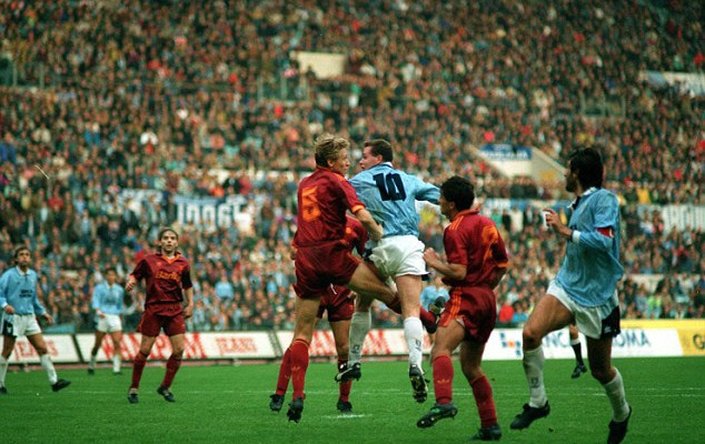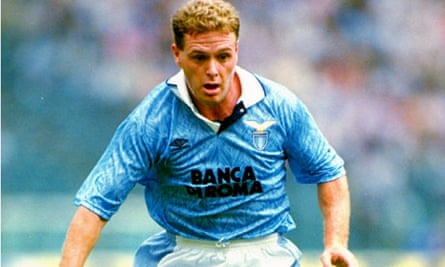Italia ’90 was a memorable tournament. Was the standard of football outstanding? No. Yet it still produced some truly iconic moments. Accompanied by the glorious soundtrack ‘Nessun Dorma’, this was the competition that delivered Roger Milla’s dancing, Jurgen Klinsmann’s theatrics, and Diego Maradona sending Italy crashing out at the semi-final stage in Naples.
It was also the event that a 23-year-old Englishman introduced himself on the world stage. His name was Paul Gascoigne. Having stuttered through the group stage, England gained momentum as the World Cup progressed, with Gascoigne at the forefront of their success.
Having set up a last-minute winner in the last 16 against Belgium, it seemed that Gascoigne might be the player to lead England to glory. Then, in the semi-final against West Germany, it all went wrong. With the scores level at 1-1 in extra-time, the young midfielder lunged in and was booked for a late challenge. If England made the final, Gascoigne would be suspended.
The player himself knew it immediately. He continued playing, but it was a struggle. England would go on to lose on penalties, leaving Gascoigne in floods of tears at the Stadio delle Alpi. It was to be the lasting image of the tournament for England fans, as the man known affectionately as ‘Gazza’ became a national treasure overnight.
Gascoigne returned to his club side Tottenham, and helped the team to the 1991 FA Cup, but at some cost. In the final, he scythed down Nottingham Forest’s Gary Charles, injuring himself badly in the process. That serious knee injury kept him out of the following campaign, but in the summer of 1992 Serie A came calling.
Clearly impressed by the dazzling skills that Gascoigne had displayed two years earlier, Lazio took a risk on the injury-plagued midfielder and brought him to Rome for £5.5m. The charismatic playmaker had the chance to shine once more in the country where he had made his name.
Things started slowly. Having joined whilst still short of fitness, he did not make his league debut until late September in a 1-1 draw against Genoa. The first two months were low-key by Gascoigne’s standards, until in the final game of November he had his first big moment. Four minutes from time in the Rome derby, Gascoigne guided home a header to rescue a point for I Biancocelesti. Gazza had arrived.

The following week saw Lazio travelling to Pescara. The hosts were in Serie A for just the fifth season in their history and were sitting rock bottom, meaning that this should have been a comfortable afternoon for Dino Zoff’s men. Nothing extraordinary needed, just three points to take back to the Italian capital. That’s not how things played out.
The first 20 minutes passed with neither side troubling the scorers. Something special was needed to break the deadlock. Step forwards Gazza.
The maverick midfielder picked the ball up ten yards inside the Pescara half and was immediately closed down by an opponent. From a standing start, Gascoigne suddenly changed gears and eased past the first challenge.
Two more defenders swiftly converged on him. He had to look for a teammate. There did not seem to be enough room to squeeze through the gap between the pair. At least, that is how a mere mortal would assess the situation. But Gascoigne did not see things that way.
Displaying a delicate touch and phenomenal balance, Lazio’s playmaker slalomed beyond the two tackles. The latter challenge did see the defender get the slightest touch on the ball, but Gascoigne was not to be denied.
He continued on. Now it was clear that he was on the brink of a truly magical goal. Only one more defender stood in his way. A passing option remained available, yet Gascoigne only had one thing on his mind. He was going this alone.
The final Pescara defender lunged in desperately. He was left kicking fresh air. Gascoigne glided past him, and was now one-on-one with the goalkeeper. There was only one final outcome. With his weaker left foot, he passed the ball calmly into the net and wheeled away to Lazio’s travelling supporters.
Holding his arms aloft above his head, Gascoigne gestured for more noise from his adoring fans. They were more than happy to oblige. As the camera panned to the crowd, there was pandemonium in the stands. In the space of five seconds, the Englishman had danced past four players and slotted the ball home with aplomb. It was a moment of pure genius, and the crowd knew it.
That was not to be the end of the entertainment either. Lazio were twice pegged back in the second half, with Massimiliano Allegri, the future Milan and Juventus manager, getting on the scoresheet for the hosts. It was left to Luca Luzardi to score a last-gasp winner for Lazio, sealing a dramatic 3-2 victory.

Gascoigne would flatter to deceive for much of his remaining days in Rome. He scored just two more Serie A goals that season, and after two more disappointing campaigns he returned to Britain in 1995.
Zoff would go on to say that watching Gascoigne waste his talent was “the biggest regret of my career.”
There is little doubt that Gascoigne could have achieved more. Yet this match against Pescara offered further evidence that he could produce moments that most others could only dream of.
Gazza was a player who would make fans jump out of their seats. He could turn an ordinary match into one that you could not take your eyes off. Statistics don’t do him justice.
Instead it is the memories that he gave supporters that has cemented his legacy. Scoring against Arsenal and Roma in some of the world’s biggest derbies. Those are moments that won’t be forgotten.
Then there was this goal in Pescara. It was a mesmeric passage of play. It was Gazza at his best. And in the early ‘90s, there were few better sights than that.
Words by: Sam Brookes. @sambrookes3177

